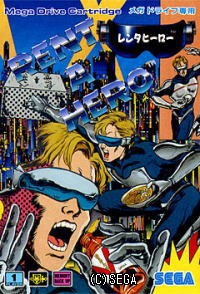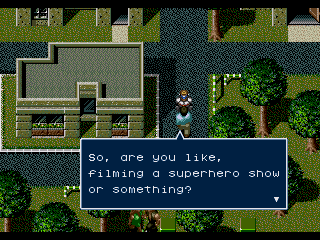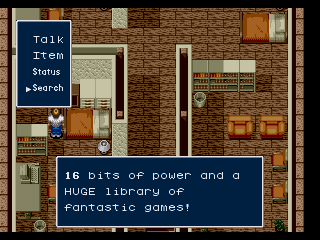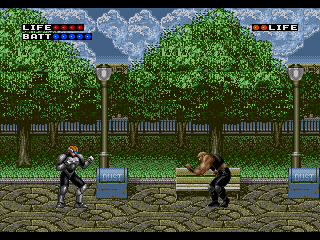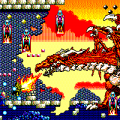Sega is a company that has always liked to celebrate in its games their most famous achievements, as titles like Shenmue attest, but at the same time was never afraid of poking fun at those and itself, as titles like Segagaga show. Sega’s AM2 division was behind the former and, about a decade before it, they made a little game for the Mega Drive that was both a parody and a celebration as well: Rent A Hero. This title is not as well-known as those because it was never released outside Japan. It didn’t even receive a complete fan translation until early 2015, when a ROMhacking.net community member finished the long-lasting work and made it available to the public. The following article and the screenshots in it are based upon this translation.
To be fair, to translate Rent A Hero‘s dialogues was not an easy task, since the whole game is not only a Sega self-parody, but also a gentle spoof of Japanese society and popular culture, mostly poking fun at the tradition of “Super Sentai”, transforming costumed heroes generally aimed at young kids. The plot is explained in a playable prologue before the titles and intro animation: the nameable protagonist (whose in-story default name is Taro Yamada, the Japanese equivalent to “John Smith”) is a regular teenager who needs to order food for a house party and phones to Sensational Cafeteria, or SECA for short. The delivery man, however, brings him a power suit that is part of the “Rent A Hero” program, giving to random people the opportunity to become heroes for hire. Taro wears the suit, thinking it could be just a fun party trick… until his father (who decided to wear a kaiju costume to amuse guests) is sent flying with just a light punch, at which point he realizes that this hero-for-hire program is an actual thing and he needs to register in order to become an official hero for Aero City.
Taro’s family is an affluent one, and he has in his bedroom, besides a Mega Drive, a powerful computer with access to the internet (in 1991!). He uses it to keep in contact with SECA headquarters, whose member Mieu (a name that Phantasy Star fans will immediately recognize) will provide new tasks for him and also the opportunity to save the game. You have to pay at fixed intervals a fee to SECA to rent the suit, but completing the tasks will reward you with money. Humorously, the in-game currency is still named “GOLD” even if the setting is contemporary Japan and not the usual medieval European fantasy world.
At first the tasks will be pretty simple, such as to deliver a love letter or save a woman who was mugged in the park, but later on the missions will become much more serious, such as collaborating with the police to bring down mafia families or arrest an industrialist who makes counterfeit bills. This one mission actually has Taro infiltrate the criminal’s company by disguising himself as a businessman and taking a job interview where he has to answer in a stereotypical “evil” way.
Some of the questions from the interview make fairly clear to Japanese people that the company’s employees are most likely yakuza (stuff like “Is the punch perm the most important hairstyle these days?”), and those, among other cultural references, are probably one of the reasons why the game has never been officially translated. Another reason could be the fact that, especially in the beginning, several NPCs have double the lines of dialogue, when speaking to both our civilian identity and our Rent A Hero public persona, which the player can name as well.
Rent A Hero‘s storyline becomes fairly serious the more Taro becomes well-known among both the citizens and the criminals, especially when the identity of who is behind the various thugs, robbers and loan sharks that infest Aero City becomes clearer; but even then the game is still full of comical and bizarre moments. For example, at one point we meet a random salaryman asking us where one can apply to become a Rent A Hero, and later on we find him robbing us of our jobs under his new identity of “Ultramanager” (an Ultraman reference, who originally was called ・Urusaraman”, a combination of “Ultraman” and “salaryman”). Near the end three archeologists excavate at a construction site an Egyptian sarcophagus (in Japan!) whose owner, the ancient pharaoh Glutenramen, challenges us to a fight. An especially moving moment for Sega fans is the arcade in one of the towns, full of past Sega coin-ops from OutRun to G-LOC and Space Harrier, all lovingly rendered in great pixel art. If you examine them, they even play a brief rendition of their most famous tunes.
The game is somewhat reminiscent of Sword of Vermilion, AM2’s earlier Mega Drive game. Like that one, it is not quite what it seems at a first glance. Vermilion looked like an example of action RPG but it was a RPG with a few action elements, and in turn Hero is an action adventure with a lot of adventure and a little action. Hero, much like Vermilion, differentiates between the overhead town segments and the side-scrolling battle scenes (the first-person segments have thankfully been left out) where you have to beat random thugs, but also hitmen, yakuza and all kinds of troublemakers. The latter ones are the game’s biggest problem: the combat is stiff and awkward, the collision detection is broken and in general fights are more of a chore than a fun part of the experience. Getting defeated is very easy (so much for super strength) and every time it happens Taro restarts from his hometown’s hospital with half of his money, a typical RPG trope that here becomes annoying since the only way to gain decent sums of money is to complete Mieu’s tasks. So remember to deposit a large part of your cash in the banks and at the ATMs, also making sure that you won’t lose the suit because of the rental being overdue.
Rent A Hero is not really a RPG though, so there are no experience points and the only way to gain new armors and weapons (that is, more hit points and new special moves for the combat sections) is to donate part of our profits to SECA’s R&D division whose scientists will give you after a while their latest discoveries. SECA in fact stands also for “Super Energy Combat Armor”. To access their labs you open a secret entrance below Sensational Cafeteria’s toilets (!). An unusual system, that however is appropriate to the mostly realistic style of the game world. There are still some RPG trappings though, like the hotels where to recover after a night of sleep, and the various supermarkets and corner shops whose only purpose is to sell energy drinks to recover our life and batteries to restore the suit’s power. Yes, SECA’s suits are battery-powered, and just walking around (not to speak of executing the super moves) consumes power, so be prepared to carry some batteries on you all the time. If the suit’s power goes down to zero, Taro turns back to his normal civilian self, who is very slow and also sucks at fighting (even more than usual), so of course you wouldn’t want that.
It’s not easy to recommend Rent A Hero in this day and age, what with the awful combat, unimpressive graphics and the generally very slow pace of the early game; if you persevere, though, you will find an original game with good writing and an interesting look at early 90s Japan, including stuff like white-collar crimes that are not usually depicted in these kind of games. The realistic setting (except for the pharaoh… what was that all about?) is also a nice change of pace from the usual fantasy RPGs and the tired “save the world” mindset, but the progression from random person to hero is still well done and engaging enough.
Rent A Hero No.1 (レンタヒーロー No.1) – Dreamcast, Xbox (2000)
About ten years later, AM2 tried to revive the franchise with a remake of the game for the then-new console Dreamcast, named Rent A Hero No. 1 (probably after a line from the original) and developed by two companies, Aspect Co. Ltd. and the unknown Coolnet Entertainment. It’s almost a shot-by-shot remake of the Genesis title with most of the original missions and characters, and it even starts with the original’s intro sequence on a TV screen, but the parody and reference angle is cranked up a lot, resulting in a zanier experience. Almost every character and store name is a pun on actual franchises or names and there are a lot of Sega in-jokes. For example, there is a character named ・Ms. Naomi” (named after the NAOMI arcade board), Taro now has “MD” and “32X” written on the back of his T-shirt among other things, he doesn’t use his computer anymore to connect with SECA but uses a Creamcast (!) with online access instead, and he learns new moves for the combat sections by going to a dojo whose owner is none other than the best video game spokesperson ever, Segata Sanshiro!
Speaking of combat, the beat-em-up sections are luckily better than the ones in the Genesis game, because the Dreamcast game’s engine is based on the earlier Sega arcade brawler Spikeout, which in turn was a sort of polygonal reimagining of the Streets of Rage series. The game’s beta version, however, had a different, turn-based combat system more befitting of an action RPG, as documented in this 1999 prototype video.
There are also a few differences in the characters from the original game. The nameless and faceless SECA R&D scientists have been replaced by one character, goofy mad scientist Dr. Trouble. For all the talk of Rent A Heroes becoming popular among the citizens, we actually met only Ultramanager; he’s back, but there’s also an actual squad of them, color-coded just like in the Sentai serials they’re parodying. And if you saw the boxes and ads above, you’ve surely noticed a girl Hero: she’s Rent A Hiroko, our player character’s female counterpart. She appeared in about every single piece of promotional material (including dolls!), but her role in the actual game is very minor. Perhaps Sega (or SECA?) intended her to be the protagonist of a following game in the series, but since it became a cult classic at best, no other ones were made. So Hiroko could never join, say, Ulala or Tyris Flare among Sega’s heroines.
The Dreamcast game (which also made use of the console’s online capabilities, including the VMU memory card) was mostly praised by the Japanese press for the frame rate that never dips below 60fps, the quality of the textures and variety of characters and urban environments, almost at Shenmue levels; unfortunately for Western Sega fans, the remake too was doomed to never leave Japan. The game was released for Xbox in Japan in 2003 and the English version was mostly completed for a North American release in early 2004, but the American publisher AIA USA first delayed the release, then went under. In this version, the Hero’s real name is John rather than Taro. And that was the last anyone heard about Hero in the West. However, the game’s files were leaked and can be found on the internet if one knows where to look.
Taro/Hero also appeared in the 1996 Sega Saturn fighting game Fighters Megamix by AM2. The game features the entire casts of Virtua Fighter and Fighting Vipers plus other random characters, and Hero is one of them, specifically a hidden one. He has the same weakness from its original game, that is, if its battery meter drops to zero before the end of the match, his armor shuts down. In the Japanese version, his theme song has vocals, but these were stripped from the Western version.
Thanks to Random Gamer Riven for the Fighters Megamix screens.
Links:
ROMhacking.net Translation of the Mega Drive game.
Sega Retro Supplementary material for Rent A Hero No.1.
Team Xbox (archived link) The reasons behind Rent A Hero No.1‘s lack of a Western release.
Giant Bomb Wide selection of Rent A Hero No.1 concept arts and promotional material.

